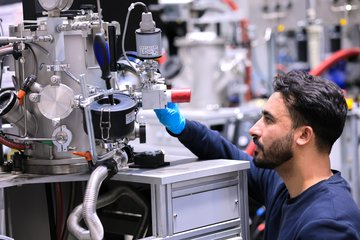All genres
1.
Journal Article
Hydrogen-based direct reduction of multicomponent oxides: Insights from powder and pre-sintered precursors toward sustainable alloy design. Acta Materialia 301, 121528 (2025)
2.
Journal Article
Unraveling the thermodynamics and mechanism behind the lowering of direct reduction temperatures in oxide mixtures. Materials Today 90, pp. 43 - 51 (2025)
3.
Journal Article
A percolating path to green iron. Cell Reports Physical Science 6 (8), 102729 (2025)
4.
Journal Article
Elucidating the microstructure evolution during hydrogen-based direct reduction via a case study of single crystal hematite. Acta Materialia 294, 121174 (2025)
5.
Journal Article
An Atomic-Scale View at g'-Fe4N as Hydrogen Barrier Material. Advanced Materials Interfaces 12 (13), 2500207 (2025)
6.
Journal Article
On the anisotropic deformation behavior of a low-density medium manganese steel. Acta Materialia 292, 121060 (2025)
7.
Journal Article
Hydrogen accommodation and its role in lattice symmetry in a TiNbZr medium-entropy alloy. Acta Materialia 288, 120852 (2025)
8.
Journal Article
Hydrogen-assisted spinodal decomposition in a TiNbZrHfTa complex concentrated alloy. Acta Materialia 285, 120707 (2025)
9.
Journal Article
Reactive vapor-phase dealloying-alloying turns oxides into sustainable bulk nano-structured porous alloys. Science Advances 10 (51), eads2140 (2024)
10.
Journal Article
Grain boundary engineering for efficient and durable electrocatalysis. Nature Communications 15, 8534 (2024)
11.
Journal Article
The Role of Dislocation Type in the Thermal Stability of Cellular Structures in Additively Manufactured Austenitic Stainless Steel. Advanced Science 11 (33), 2402962 (2024)
12.
Journal Article
Designing advanced high-Cr ferrous alloys for next-generation energy applications through cryogenic processing. Applied Surface Science 665, 160290 (2024)
13.
Journal Article
Circular Steel for Fast Decarbonization: Thermodynamics, Kinetics, and Microstructure Behind Upcycling Scrap into High-Performance Sheet Steel. Annual Review of Materials Research 54 (1), pp. 247 - 297 (2024)
14.
Journal Article
Ultrastrong and ductile NiTi-based composite with large recoverable strain mediated by a compositionally complex phase. Applied Materials Today 39, 102347 (2024)
15.
Journal Article
Green Ironmaking at Higher H2 Pressure: Reduction Kinetics and Microstructure Formation During Hydrogen-Based Direct Reduction of Hematite Pellets. Journal of Sustainable Metallurgy 10, pp. 1127 - 1140 (2024)
16.
Journal Article
Thermal Kinetics and Nitriding Effect of Ammonia-Based Direct Reduction of Iron Oxides. ACS Sustainable Chemistry & Engineering 12 (26), pp. 9882 - 9896 (2024)
17.
Journal Article
Hydrogen-based direct reduction of combusted iron powder: Deep pre-oxidation, reduction kinetics and microstructural analysis. Acta Materialia 268, 119752 (2024)
18.
Journal Article
Unravelling the effect of F phase on hydrogen-assisted intergranular cracking in nickel-based Alloy 725: Experimental and DFT study. Corrosion Science 225, 111569 (2023)
19.
Journal Article
How much hydrogen is in green steel? npj Materials Degradation 7 (1), 78 (2023)
20.
Journal Article
Segregation-enhanced grain boundary embrittlement of recrystallised tungsten evidenced by site-specific microcantilever fracture. Acta Materialia 259, 119256 (2023)











